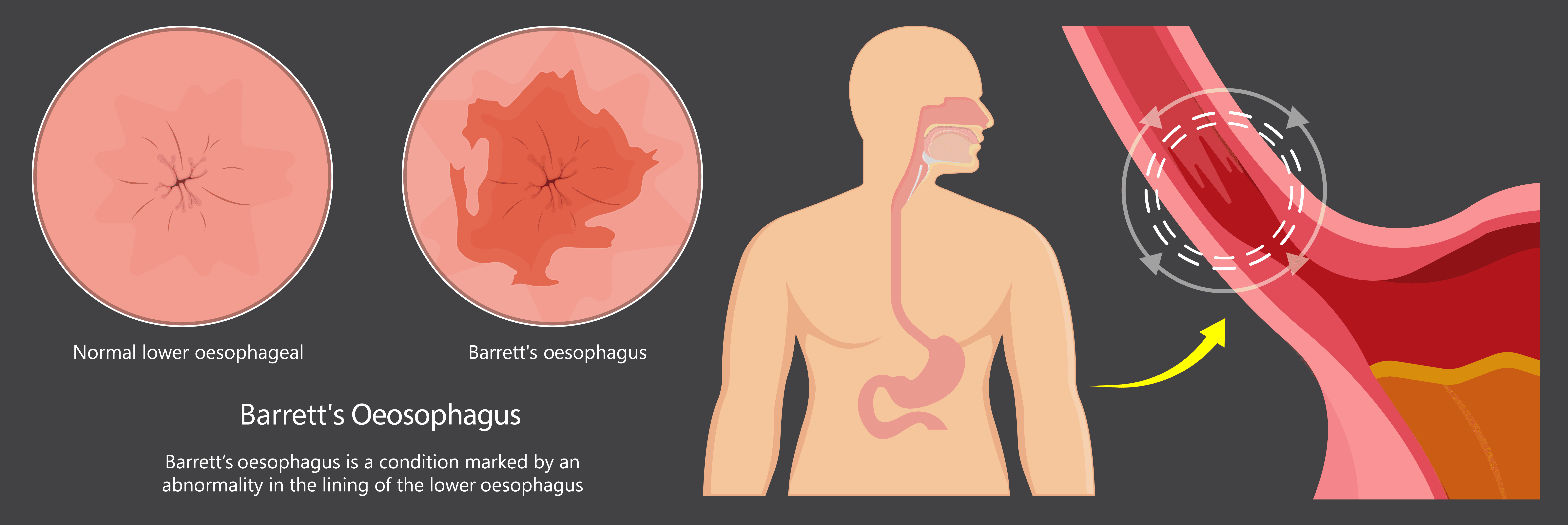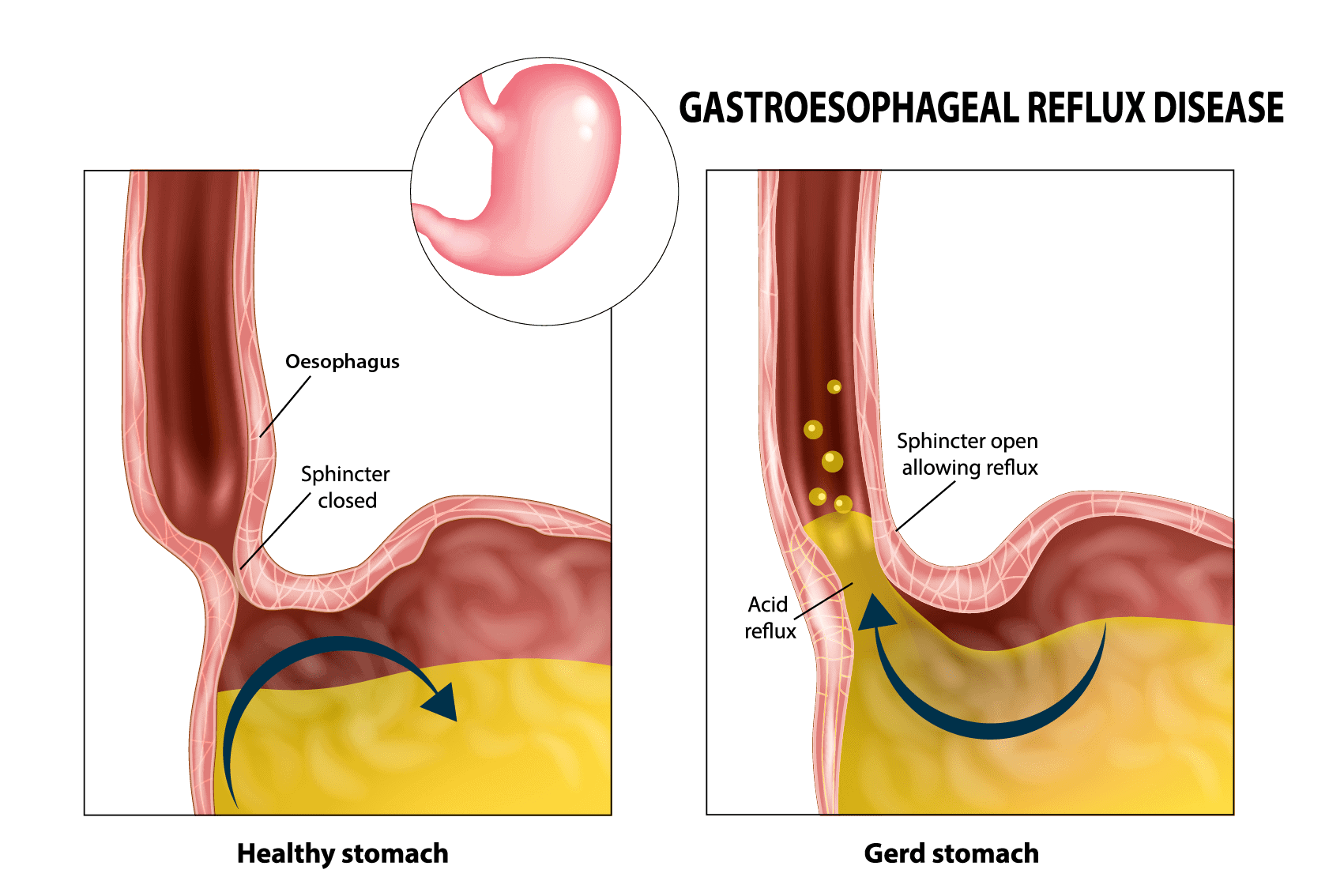
What is Barrett’s Oesophagus?

The oesophagus is a long, hollow tube that runs from the throat to the stomach. The oesophagus forms part of the upper gastrointestinal tract and helps to carry the food that we chew in our mouths down to our stomachs for digestion.
Barrett’s oesophagus is a premalignant condition of the oesophagus. It occurs when there are changes to the cells of the lower oesophagus due to damage done by long-standing acid reflux. As stomach acid and chemicals wash back up into the oesophagus, the tissues in the oesophagus are irritated and damaged, which subsequently causes changes in the cells lining the oesophagus. The cells undergo changes in their DNA, and the lining of the lower oesophagus thickens and reddens. Patients with Barrett’s oesophagus have a higher risk of developing oesophageal cancer compared to the general population.
While the exact cause of Barrett’s oesophagus is not known, many with Barrett’s oesophagus have a long-standing history of gastroesophageal reflux disease (GERD), which is a condition where the acid that digests food in the stomach refluxes upwards into the oesophagus. Approximately 5% of patients with chronic GERD develop Barrett’s oesophagus. However, Barrett’s oesophagus can also develop without having GERD.
Stages of Barrett’s Oesophagus
The severity of Barrett’s oesophagus is measured by determining the degree of tissue change in the oesophagus. A pathologist, who is a doctor who trains and specialises in examining body tissues in a laboratory, will examine a tissue sample obtained from your oesophagus and determine the degree of abnormal change, or dysplasia, in your oesophageal cells.
Tissue change can be classified as:
- No dysplasia — Barrett’s oesophagus is present, but there are no precancerous changes found in cells
- Low-grade dysplasia — cells show small signs of precancerous changes
- High-grade dysplasia — cells show many changes. High-grade dysplasias are thought to be the final stage before cells change and develop into oesophageal cancer
Risk factors for Barrett’s Oesophagus
There are several risk factors which predispose to the development of Barrett’s oesophagus:
- Having a family of Barrett’s oesophagus or oesophageal cancer
- Acid reflux and heartburn symptoms for 10 or more years
- History of GERD
- Male
- Being over 50 years old
- Current or past smoking
- Obesity
- Being of the Caucasian race
What are the Symptoms of Barrett’s Oesophagus?

On its own, Barrett’s oesophagus does not present with any specific symptoms. Because of this, its exact prevalence in the general population is not known. However, the development of Barrett’s oesophagus is often attributed to long-standing GERD, and patients with Barrett’s oesophagus would have typically experienced symptoms associated with GERD, which include:
- Frequent heartburn and regurgitation of stomach contents
- Difficulty swallowing food
- Chronic cough
- Chest discomfort or chest pain
How is Barrett’s Oesophagus diagnosed?

Endoscopy is generally used to diagnose Barrett’s oesophagus. During this procedure, doctors will pass a small, flexible, lighted hollow tube (endoscope) equipped with a video lens down your throat and into your oesophagus. Through the video lens, the doctor can look at the inside of your oesophagus and help to identify any changes in the lining of the oesophagus. Normal tissues tend to appear pale and glossy, while in Barrett’s oesophagus, the tissue is red, thick, and velvety.
During the endoscopy procedure, the doctor will remove some tissue from the oesophagus (biopsy). The biopsied tissue will then be sent to a laboratory to be examined by a pathologist to determine the degree of changes in the cells in the tissue obtained.
While the appearance of the oesophagus seen during the endoscopy might be able to suggest a diagnosis of Barrett’s oesophagus, the diagnosis can only be confirmed once a biopsy is obtained through the endoscopy and examined by a pathologist.
Can Barrett’s Oesophagus be cured?
Currently, there is no definitive cure that can reverse the disease. However, acid-suppressing medications such as proton-pump inhibitors (PPIs) are useful to help prevent further damage to the oesophagus and may have a slight chance of healing some existing damage. Being treated for GERD, if present, can also help to prevent the disease from further progression.
Lifestyle modifications can also be useful in helping to reduce risk. These include avoiding drinking alcohol, quitting smoking, and maintaining a healthy weight and diet.
Because Barrett’s oesophagus is a potentially precancerous condition, medical attention is important and necessary. Long-term follow-up is important to monitor the progress of the disease, and this may include intervals of diagnostic testing with endoscopy throughout treatment, as well as treatments to remove damaged tissue.
Dr Benjamin Yip cautions that although the risk for developing oesophageal cancer in a patient with Barrett's oesophagus is generally low, oesophageal cancer is a very deadly cancer. Therefore, it is a good idea to see a Gastroenterologist in order to assess your risk of developing oesophageal cancer if you are diagnosed to have Barrett's oesophagus.
How is Barrett’s Oesophagus treated?
Treatment depends largely on the presence of symptoms and the type of dysplasia seen during a biopsy.
- No dysplasia — treatment is usually not required at this stage, but patients would typically need some form of long-term monitoring, with endoscopy every two to three years. Medications may also be prescribed for patients with GERD to help decrease stomach acid production, to reduce irritation and damage to the oesophageal lining.
- Low-grade dysplasia — long-term monitoring with endoscopy is typically required for cases of low-grade dysplasia, with endoscopy every six months to a year. Ablation therapy to remove precancerous cells might also be recommended for some patient cases
- High-grade dysplasia — with this diagnosis, the risk of oesophageal cancer is higher. Repeat endoscopies will have to be performed more often to monitor for cancerous changes. Other treatment options may also be recommended, such as radiofrequency ablation (burning off tissues with radio waves that generate heat), endoscopic mucosal resection (removing precancerous spots in the oesophagus via endoscopy), and surgery where an oesophagectomy is performed to remove all or part of the oesophagus.
What is Short Segment Barrett’s Oesophagus?
Barrett’s oesophagus is often categorised into short- or long-segment based on the length of the oesophagus that is affected by the development of abnormal cells (dysplasia). Short-segment Barrett’s oesophagus usually refers to the involvement of less than 3cm of the lower oesophagus.
What can I eat if I have Barrett’s Oesophagus?
There is no specific diet for Barrett’s oesophagus. If GERD or heartburn is present, diet changes can be made to help control symptoms:
- Avoiding eating large meals, and instead of spreading meals out into smaller, more frequent portions
- Having dinner >3 hours before bedtime
- Reducing intake of spicy and oily food
- Not lying down for at least 30 minutes after a meal
- Staying well-hydrated
Will I get cancer if I have Barrett’s Oesophagus?
While Barrett’s oesophagus is a premalignant condition, most do not develop into oesophageal cancer. However, although the risk of developing cancer is small, it is important to have regular checkups so that any signs of cancer can be detected early.
Some red flag symptoms that warrant a visit to the doctor include:
- Have difficulty swallowing
- Having a sensation of food being stuck in your throat or chest
- Heartburn that is progressively getting worse and waking you up from sleep
- Experience unexplained, unintentional, and significant weight loss over a short period
- Are vomiting red blood or blood the colour of coffee grounds
- Are passing black, bloody, or tarry stool
Summary
Overall, being diagnosed with Barrett’s oesophagus should raise alarm bells. It is good to understand and remember the details of this condition to help you better understand your risk profile and take measures to manage your condition and prevent it from worsening.
If GERD is present, it is also good to keep the GERD symptoms under control and to have good adherence to medication. Regular follow-up with endoscopy tests is also imperative in helping patients with Barrett’s oesophagus to monitor and maintain their health.
References
- “Barrett oesophagus.” PubMed, 23 May 2019, https://pubmed.ncbi.nlm.nih.gov/31123267/. Accessed 1 September 2022.
- “Barrett's oesophagus: epidemiology, diagnosis and clinical management.” PubMed, 3 October 2016, https://pubmed.ncbi.nlm.nih.gov/27681974/. Accessed 1 September 2022.
- “Barrett's oesophagus | Oesophageal cancer.” Cancer Research UK, https://www.cancerresearchuk.org/about-cancer/other-conditions/barretts-oesophagus/about-barrett%27s. Accessed 1 September 2022.
- “GERD (Chronic Acid Reflux): Symptoms, Treatment, & Causes.” Cleveland Clinic, 6 December 2019, https://my.clevelandclinic.org/health/diseases/17019-gerd-or-acid-reflux-or-heartburn-overview. Accessed 1 September 2022.
- Rogers, Graham. “Barrett's Esophagus: Causes, Risk Factors & Symptoms.” Healthline, https://www.healthline.com/health/barretts-esophagus. Accessed 1 September 2022.

